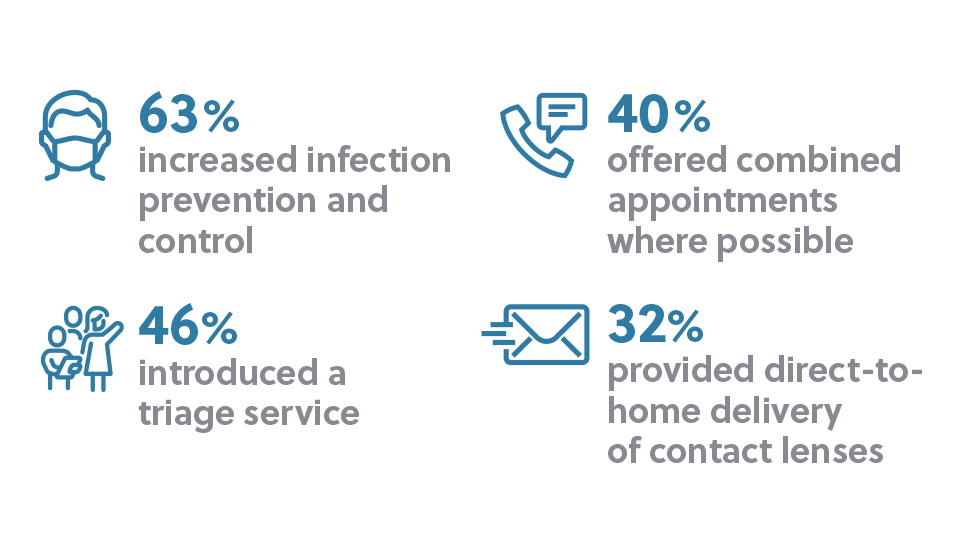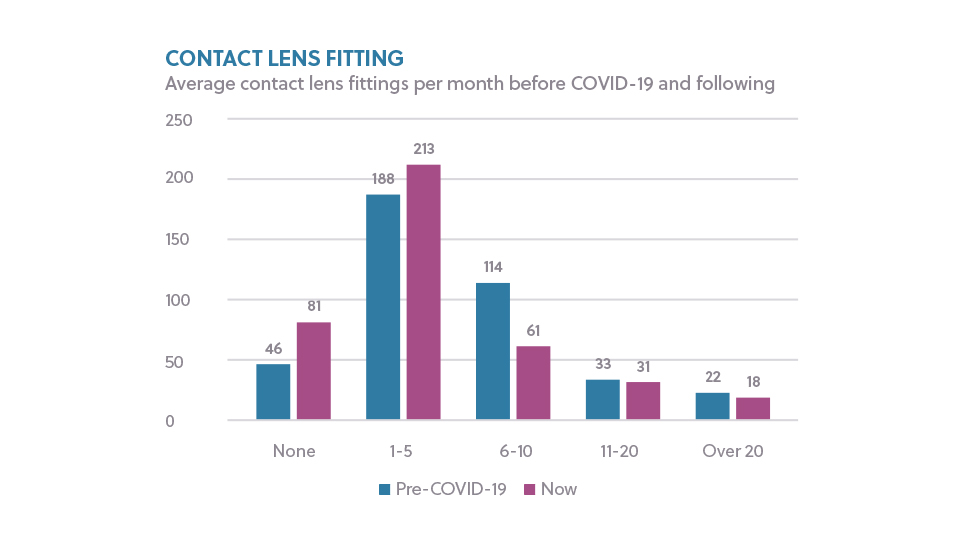- OT
- Industry
- Contact lenses
- COVID-19 and contact lens practice: a novel challenge and an opportunity
COVID-19 and contact lens practice: a novel challenge and an opportunity
A reader survey held by OT and CooperVision has illustrated the impact of the pandemic on practices and contact lens services, and some of the ways ahead

28 September 2021
Increased personal protective equipment, the use of enhanced triage, combined appointments, direct-to-home contact lens delivery – practices have adapted their contact lens journey in a myriad of ways during the pandemic to continue meeting the needs of patients.
The participants
The survey polled 589 people which included 256 employed eye care professionals, 169 practice owners and 143 locums, along with 15 unemployed members and six pre-registration optometrists.
Samantha Armstrong, professional services consultant for CooperVision, commented: “The survey is a temperature check to discover where we are as a profession emerging from the pandemic. We wanted to know what changes were implemented during the more severe stages and whether these had enabled new ways of working going forward.”
Discussing the survey, Ann Tenison, customer marketing manager for CooperVision, said: “It is important for us to understand the concerns and mindsets of our eye care professionals (ECPs) so that we can better serve the contact lens category by addressing their needs and those of the patient.”

Adapting to COVID-19
Exploring the new protocols and services that have been introduced following the pandemic, infection control and social distancing measures were understandably the most-introduced measures in practice, selected 63% and 61% of the time respectively.
Remote consultations over the phone were also implemented by over half of practices (53%), while triage protocols were launched by 46% of respondents.
Although this has now ended, an easement introduced by the General Optical Council (GOC) allowed for practices to adjust their services to continue providing patients with their contact lenses during the pandemic. The survey found that extended contact lens specifications were introduced by 39% of respondents, along with extended recall periods (35%).
Direct-to-home delivery of contact lenses was introduced by 32% of respondents during the pandemic, while email or online ordering of contact lenses was introduced by 15% of those surveyed.
Of the changes practices introduced during the pandemic, 35% of respondents felt that they would continue combining sight test and aftercare appointments, while 34% said they would plan to continue telephone triage.
For those who offered the service, 28% would continue direct-to-home delivery of contact lenses, compared to 16% who said they would continue to provide email or online contact lens ordering beyond the pandemic.
Exploring other services provided, 17% said they would continue to offer email support to patients, while 11% said they would provide pre-fit educational material to patients ahead of appointments.
CooperVision reflects: direct-to-home deliveries
The majority of practitioners expressed confidence in using these tools, with 68% of respondents reporting feeling “confident” or “very confident” around direct deliveries, and 50% saying the same for email or online ordering.
Discussing the benefits of the service for practices, Armstrong said: “It is better from a time, space and safety perspective. Products do not need to be stored, handled and organised if sent direct.”
Building on these findings, Tenison shared that a CooperVision survey of patients last year found that 83% of respondents wanted their optometry practice to “provide a service to deliver contact lenses direct to my house or work rather than a store pick-up.”
Tenison pointed out that consumers’ habits and behaviours could have changed during the pandemic, emphasising a need for direct deliveries. She said: “The lockdowns have been on and off for around 18 months, so it is quite likely that [direct deliveries] are now the norm from a patient’s point of view. If availability of direct delivery services change, it becomes an inconvenience.”
Remote care
Although recently updated, statements from the GOC and joint regulators during the early phases of the pandemic allowed practitioners to introduce elements of remote services to manage patients safely during lockdowns.
Remote consultations through phone calls were introduced by 53% of practitioners during the pandemic, something that 34% of respondents expressed an interest in seeing in use beyond the pandemic. In comparison, remote consultations through teleconferencing systems were introduced by smaller numbers – 15% of respondents.
Recognising the benefits of remote/virtual consultations, 36% of respondents said patients appreciated the ease of the service, whilst for 31% of respondents, remote services facilitated quicker communication with patients.
Sharing their levels of confidence in offering the protocols and services, however, respondents admitted to feeling less confident around remote consultations through teleconferencing platforms (34% felt ‘not confident at all’ or ‘not very confident’) than over the phone, (which only saw 20% of respondents say they were ‘not confident at all’ or ‘not very confident’ and 59% saying they felt ‘confident’ or ‘very confident’).
Challenges of remote services varied from the technology itself to levels of comfort. The survey found 20% of respondents felt it was time consuming, and a further 20% and 16% felt patients struggled to use the technology or were not comfortable with it.
Views of the importance of virtual services in contact lens care going forwards also varied, with many feeling neutral towards this, 8% and 27% respectively suggesting it would be ‘very important’ or ‘important,’ compared to 20% who felt it would not be very important, and 12% who felt it wouldn’t be important at all.
CooperVision reflects: remote services
Reflecting practitioners’ concerns, the survey found that clear definitions and guidance would be needed if remote tools were to be used in the future.
Armstrong commented: “People are looking for really clear guidance about what they can and can’t do to be able to move practices forward, try to overcome the barriers they are having with time, and plan a bit better with their patient journeys.”
However, remote tools and services do not need to mean telemedicine, CooperVision highlighted, but could be as simple as a courtesy phone call, or automated text messaging services such as those provided through CooperVision’s My Lens Coach, supporting patients through the contact lens journey and encouraging retention.
Tenison noted that, when thinking about remote technologies, often thoughts turn straight to full eye examinations and the challenges involved, “Instead of talking about how we help and guide patients through the process and create more efficiencies within your practice and the patient journey.”

Contact lens fitting
Interested in understanding what impact the pandemic may have had on practices’ contact lens business, OT and CooperVision asked optometrists to share how many they are currently fitting on average compared to pre-pandemic.
The survey saw an overall reduction in the average number of contact lenses fitted per month compared to pre- pandemic, finding that almost double the number of respondents reported fitting no contact lenses per month at the time of the survey (20%) than they had before the pandemic (46%).
Those fitting one to five contact lens patients per month rose slightly from 46% pre-COVID-19, to 53% following the pandemic, but the number of optometrists who had been fitting six to 10 contact lenses per month before the pandemic dropped by almost half from 28% pre-COVID-19 to 15% currently.
Those delivering more fittings before the pandemic saw the greatest stability, with 8% fitting 11–20 contact lenses a month on average both before the outbreak and following, while the 5% of respondents fitting over 20 contact lenses a month before the pandemic, dropped only slightly to 4%.
There were many practices who felt that the regular revenue from contact lenses was vital to keeping afloat during the time when the practice doors were closed
The survey also explored the place contact lenses held within practices and their priorities moving forwards. Asked what percentage of the business is made up of contact lenses, the majority of respondents estimated between 11-20% and 21-30% (25% and 21% respectively). A further 16% felt that contact lenses made up 1-10% of their business, while 14% felt it represented 31-40%. A combined 18% of respondents felt contact lenses fell somewhere between 41-100% of their overall business.
As the country moved out of lockdown, spectacle sales were identified as a business priority by half of respondents, followed by sight tests (42%), enhanced services (35%) and contact lenses (27%).
CooperVision reflects: making contact lenses a priority
“We do know that demand for contact lenses declined a little because people were working from home so there wasn’t the need for them that there was usually,” Armstrong added. “It will be interesting to see how this alters in the coming months as the population’s ways of working and shopping evolve.”
When considering the impact of the pandemic on practices, Tenison shared: “The results of the survey would suggest that the focus has been directed to spectacles for their instant revenue generation, compared to the long-term streams from contact lenses.”
For some, however, contact lens services were crucial, Armstrong shared: “There were many practices who felt that the regular revenue from contact lenses was vital to keeping afloat during the time when the practice doors were closed.”
The experts highlighted how, by recommending both spectacles and contact lenses to patients, not only would this fulfil patients’ desires to be given informed choice, but it also can provide short-term and long-term solutions for practices. Armstrong added: “Contact lenses can help to future proof the practice. If anything happened to close the doors in future or restrict trading, there is still a revenue stream to help support the business.”

Recommending contact lenses
With practices adapting to the pandemic, the contact lens patient journey also saw adjustments. The survey found that 40% of respondents have introduced combined appointments where this was possible, while 39% introduced extended aftercare intervals.
Other changes introduced included extended appointment times, a change in the routine tests used, more flexible opening hours and the use of more technology for imaging.
The majority of respondents said they were confident recommending contact lenses to new or lapsed wearers, with 84% reporting feeling ‘very confident’ or ‘quite confident’. However, 10% expressed feeling ‘tentative in the current environment’ and 11% reported feeling ‘not confident at all’.
Considering the reasons that optometrists might be more tentative, 21% of practices identified time constraints, while 20% highlighted proximity concerns. Another 11% pointed to business priorities as their reasoning, while 10% identified hygiene as a challenge.
CooperVision reflects: engaging new wearers
The challenge of time was a key thread throughout the survey responses, particularly in light of a backlog of patients who were not able to attend practice during the pandemic, or who are overdue an appointment.
Armstrong commented: “There is a challenge for practices to find time to fit new contact lens wearers, combined with managing overdue aftercares which have the potential to initiate contact lens drop out.”
“A large concern is that practices are so busy catching up, there may be less opportunity to complete new contact lens fits,” Armstrong noted. “But, we know as social and leisure facilities re-open, wearers are wanting to embrace contact lenses, either as lapsed or new wearers.”
The experts suggested it is important to continue talking about contact lenses with potential new wearers, sharing: “We know that patients want to be offered the choice and want informed choice – data from surveys suggest that 50% of new wearers will find information online prior to an appointment.”
Future practise
With restrictions ending at the time of the survey, the majority (82%) of practitioners shared that patients seemed comfortable or very comfortable coming into the practice for face-to-face appointments.
Looking ahead, many respondents shared that they were looking forward to returning to ‘business as usual,’ though noted that changes might be needed to ensure continued safety and comfort. Some felt the changes they had introduced over the past two years had created new efficiencies or a more positive patient experience.
Those with concerns particularly identified issues around patient numbers – with some city centre practices and areas affected badly by local lockdowns experiencing a decrease in footfall. On the other hand, many optometrists expressed concern about increased demand and the need to catch up on a backlog of appointments.
Different ways of communicating with and supporting patients will enable the feeling that the patient is receiving a personalised service that best suits their needs
Job security continued to be a concern for some optometrists, along with safety concerns and the need to remain cautious in the event the reintroduction of restrictions.
As well as being mostly optimistic about the possibilities the future could hold, many optometrists also saw value in continued education and training. The survey found that 55% of respondents were interested in seeing more staff training from contact lens manufacturers, 54% wanted to see more learning opportunities, and 51% wanted more CET.
CooperVision reflects: optimism, challenges and education
The survey particularly illustrated the backlog of appointments as a concern for practices Armstrong suggested, dividing into three categories: “Clinical concerns such as missing patient problems, or retaining contact lens patients, being able to see the patients within an appropriate time window, and the juxtaposition of wishing to increase volume and sales, all while maintaining safety is a real challenge.”
She added that: “considering using digital tools such as texts, emails and post fit phone calls, streamlining customer journeys to enable combined appointments and ensuring patients are put on appropriate aftercare recall dates, (following current research regarding 24 months aftercare), can all help to reduce this squeeze in time pressure.”
Overall, however, ECPs appear to have remained optimistic and particularly valued continued education.
“It’s almost inspired the desire for more knowledge,” Armstrong said. “In response, we have been using innovative and engaging ways of educating, alongside the more traditional methods. Utilising the CooperVision Learning Academy to make learning convenient and current.”
Peer-to-peer education will be a key part of building on the learnings from the pandemic and is something CooperVision will continue to support.
Looking ahead, Armstrong advised practices not to solely focus on ‘fixing’ challenges brought about by COVID-19, but to also think about opportunities to build the practice up “and make things even better.”
“Look at what has worked well and develop further to suit the changing needs of your patients,” she said.
Tenison added that tools and technology are not a one-size fits all solution for practices “Different ways of communicating with and supporting patients will enable the feeling that the patient is receiving a personalised service that best suits their needs.”


Comments (0)
You must be logged in to join the discussion. Log in